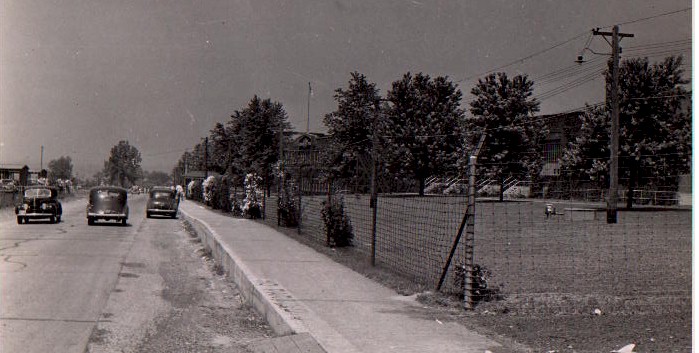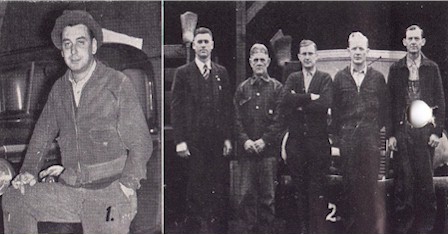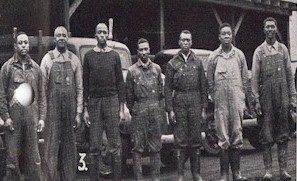| Do you drive a two-door
Chevrolet, Ford or Plymouth sedan to work? If so, you are the
average Old Hickory Rayon employee, at least as far as your car is
concerned. If your present automobile is a 1946 or later model you
belong with the two out of five employees who own a post-war
model. These statements are based on a recent survey of the plant
parking lot which was made on a representative week day morning at about
10:00 o'clock.
This survey revealed some interesting
facts concerning the preferences of you and your fellow employees in
regard to your means of transportation. On this particular day the
parking lot contained 533 passenger cars, 6 station wagons, 11 trucks,
three jeeps, two motorcycles, one motorbike and two bicycles. Of
the total passenger cars, 277 were four-door sedans, 60 were coupes and
9 were convertibles. Surprisingly enough, black and colored cars
ran almost equal with 265 blacks against 268 colored models. Among
the colors, various shades of blue are the most popular, closely
followed by red, with grays, greens and tans about equal among the
remainder.
This survey further revealed that in both
pre-war and post-war models more of our employees prefer Chevrolets with
Fords running a fairly close second. On the day of the check, 152
"Chevies" were counted, along with 106 Fords and 75
Plymouth. Dodges and Pontiacs rated fourth and fifth in popularity
with very little difference between the next four spots shared by
Studebakers, Buicks, Oldsmobiles and Hudsons. Al the other makes
were present but in numbers less than ten. The only one having the
distinction of driving exclusive models were the drivers of a 1939
Hupmobile and an early '40 model La Salle.
The automobile has become synonymous with
the American Way of Life. In the world today there are
approximately 39 million cars. Thirty-three million of them are
owned by Americans. By this it can be seen that only a very few
people in other lands own an automobile while we all know that a large
percent of American families own at least one car.
But how does the Old Hickory Du Pont
Rayon employee stack up in the ownership of new cars compared with the
overall picture throughout the state and count? According to
figures furnished by the Nashville Automobile Club, there were 515,910
passenger cars registered in the State of Tennessee for 1948. Of
this number, approximately 20% are post-war models. In Davidson
County there are 58,524 automobiles presently registered with also about
20% having been manufactured since the war. However, in our
parking lot, out of the total 533 cars counted, 191 or 35.8% were
post-war models.
According to a survey made last year by
"Better Living" magazine, 72.8% of the male Du Pont employees
own a car. The percentage at Old Hickory is sure to run quite a
bit higher than this as many of our girls drive their own car.
While most of us like to think of ourselves as an average American wage
earner, the results of this survey would indicate that in respect to
automobile ownership, both postwar and pre-war models, the Old Hickory
Rayon employees are above the average.
However, regardless of whether you drive
a sleek, chrome-trimmed model right out of the showroom or a faithful
'29 model, it should be remembered that any automobile is only as safe
as its driver. Of course you should see that your car is always in
good mechanical condition, but more important you should drive with the
view in mind of living and avoiding hospitals. It seems ironical
that the automobile, which has contributed so much to our progress
throughout the past decade, should during the same time become an
instrument of death. When you are driving remember your safety
training, use common sense, be considerate of the other fellow, and
continue to enjoy the pleasure that your automobile affords.
|
|
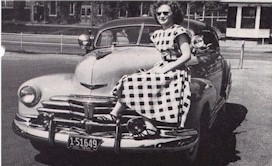
Many
of the female employees are car owners. Among these are
Helen Owen, Winder Operator on B Shift, 2-B Textile. Helen
is justly proud of her first car, this '48 two-toned sedan.
Like the majority of Rayon Employees' cars, it is well equipped
with seat covers, radio and heater. This car has brought
additional pleasure to Helen's leisure hours and she practices
safe driving so that she may continue to enjoy herself.
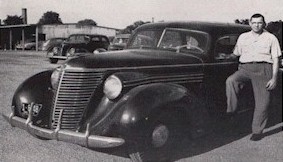
Having
the distinction of driving an exclusive model, at least on the day
of the parking lot survey, is Carl F. Henderson, Maintenance
Electrician. While this particular make is no longer being
manufactured, Carl's 1939 model Hupmobile is still in excellent
condition and as this picture indicates, is a good looking
car. Bought new by his parents, the car has actually been
driven only 43,000 miles. (Note: in the background you can
see the parking sheds that were at one time available to
employees. The sheds were dismantled in 1956. The shed
appears in the photo below as well. )
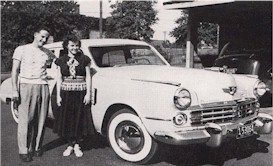
On the
day of the parking lot survey, this 1949 Studebaker "Land
Cruiser," owned by Robert J. Allen and his wife, Virginia,
both of A Shift, 2-B Textile, was the newest car in the lot.
It was right out of the showroom with only 179 miles on the
speedometer. There were 23 Studebakers in the lot and 9 of
them were post-war models.
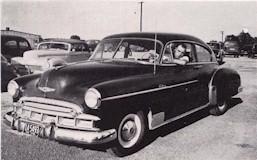
Lewis
Vance, Wringer Operator on A Shift, Plant One Spinning, could be
called the representative Old Hickory Rayon automobile
owner. According to the record survey, a black, two-door
Chevrolet is the most popular model with Rayon employees.
Lewis recently joined the ranks of those who prefer
"Chevy" by purchasing this streamlined 1949 sedan.
|






